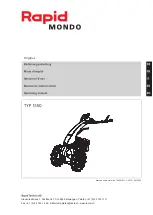
■
Lamp House Replacement Type (Fig. 6: Example LKAB037032)
Attach the lamp house to the existing pipe.
Connect the electric wires in the existing junction box.
NB1:
NB2:
■
Attachment of Cable Gland (Fig. 7: Example ZCGS-22B)
NB1:
NB2:
Screw in the lock nut on the body until it touches the body flange.
NB: Waterproof the threaded connection.
Fasten the cable retaining plate on the cable fixing member.
NB: Confirm that the cable does not move.
NB1:
NB2: The cable gland should be a product as specified by SEIWA.
The LED lamp is turned on by applying the rated voltage to the power cable of the product.
■
Inspection
1)
2) Prior to maintenance, be sure to turn off the power.
3) Carry out maintenance properly in accordance with the related law and regulations.
4) If a repair is needed, consult us.
1) In the period when the product is in use, never disassemble it.
2) For disposal of the product, follow the regulations and rules of your local government.
Before attaching the lamp house, check the existing piping (including
the pipe and junction box) for corrosion.
Pass the electric wires (white and red: power wires, black: grounding
wire) through the pipe (existing or supplied pipe) and the existing
junction box.
Tighten the locking screw on the body to prevent the cable
fixing member from loosening.
If the product is used in a place subject to water splashes,
waterproof the connection between the lamp house and the
existing pipe.
Attach the protective tube to the connecting member, then
screw the cover into the body securely.
Confirm that the cover is invisible from the O ring. If visible,
the waterproofness is not ensured.
How to Use
Maintenance
Disassembly and Disposal
Separate the cable gland into parts as shown in Fig. 7 and pass
the cable through the cable gland in the following order:
cover, connecting member, cable fixing member, washer,
rubber sleeve, washer, body, and lock nut.
The cable should be a round cable applicable to the rubber
sleeve. For information on cables applicable to the cable
gland, see the catalog.
Be sure to remove the locking screw on the cable gland
body before separating the cable gland into parts.
Tighten the lock nut toward the terminal box (or the device to
which the gland is to be attached).
In cleaning the fitting, gently wipe with water or mild detergent. Don
’
t use thinner, benzene or alkaline detergent. Such
chemicals might cause discoloration or deterioration in quality and strength, resulting in a damage.
Fasten the gland onto the entry of the terminal box (or the
device to which the gland is to be attached) until the body
stops.
Push the washer, rubber sleeve, and washer into the body and
pull out the cable to a sufficient length for cable connection.
Screw the cable fixing member into the body.
Existing junction box
Existing pipe
Power cable
Lamp house
Fig.6
Fig.7
Lock nut
2-Washers
O ring
Terminal box
Locking screw
Body
Rubber sleeve
Cable fixing member
2-Cable fixing screws
Cable retaining plate
O ring
Connecting member
Cable gland (ZCGS)
Cover
Cable (round)
- -
























